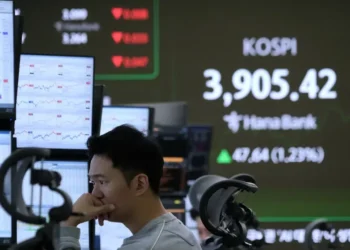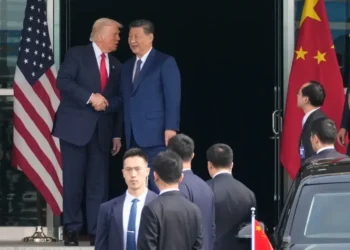Industrial “Chinatowns” in Northern Mexico Brace for Possible Trump Tariffs
An industrial development in northern Mexico, just hours from the U.S. border, is rapidly becoming home to dozens of Chinese manufacturing companies. Known for its Chinese-style architecture and bilingual signage, this thriving industrial hub is part of a broader trend of Chinese companies “nearshoring” their operations to Mexico to take advantage of tariff-free access to the U.S. market under the USMCA trade deal.
However, with the looming threat of tariffs from President-elect Donald Trump, these businesses are bracing for uncertainty. Companies like Kuka Home North America, based in Monterrey, are concerned about the future of their operations should Trump impose a 25% tariff on Mexican goods.
Nearshoring: A Growing Trend for Chinese Businesses in Mexico
The rise of these industrial Chinatowns, especially around Monterrey, is a direct result of the U.S.-Mexico-Canada Agreement (USMCA). Since the tariffs were introduced in 2018, many Chinese companies have opted to move their manufacturing to Mexico, a decision that has boosted both local and national economies.
César Santos, who began developing a 1,500-acre industrial park in 2013, has seen tremendous growth in Chinese investment. With products ranging from electronics to furniture, the goods produced in these factories are mostly destined for U.S. consumers. Santos believes that even with the possibility of a 25% tariff, many companies would still prefer manufacturing in Mexico over China due to the proximity to the U.S. market and lower costs.
Building Bridges Between Mexican and Chinese Cultures
The industrial parks have fostered new relationships between Mexican workers and Chinese companies. Developers like Ramiro González, known by his Chinese nickname “Da Long,” are adapting to the cultural differences in order to streamline construction and operations.
While challenges remain for Chinese workers adjusting to life in Mexico, such as homesickness and different customs, many have become more integrated into the local culture. Zhang Jianqiu, an engineer from China, now acts as a bridge between the two communities, helping Chinese companies navigate the Mexican business environment.
The Potential Impact of Tariffs
Despite the optimism surrounding the growth of industrial Chinatowns, the looming tariff threat remains a concern. A 25% tariff on Mexican goods would likely increase prices for U.S. consumers and could force many companies to reconsider their operations in Mexico. Matt Harrison, president of Kuka Home North America, has already halted construction on a new facility due to the uncertainty surrounding the tariffs.
Horacio Carreón, an assistant professor of international business at Tecnológico de Monterrey, highlights the delicate position Mexico finds itself in. As a crucial business partner for both China and the U.S., Mexico must assess how to navigate the shifting geopolitical landscape.
Mexico’s Future as a Key Player in Global Trade
Mexico has experienced record-breaking investment in recent years, and in 2023, it surpassed China as the leading exporter to the U.S. González and Santos are both bullish on the future of industrial parks in Mexico, but they acknowledge the challenges ahead. If the U.S. market becomes too difficult to navigate, they’re prepared to look to Latin America and beyond.
Ultimately, the situation remains uncertain as businesses in northern Mexico await clarity on the incoming U.S. administration’s trade policies. While the threat of tariffs may change the dynamics, the region’s strategic location and robust infrastructure will continue to attract investment from Chinese companies seeking access to the U.S. market.
This article was rewritten by JournosNews.com based on verified reporting from trusted sources. The content has been independently reviewed, fact-checked, and edited for accuracy, neutrality, tone, and global readability in accordance with Google News and AdSense standards.
All opinions, quotes, or statements from contributors, experts, or sourced organizations do not necessarily reflect the views of JournosNews.com. JournosNews.com maintains full editorial independence from any external funders, sponsors, or organizations.
Stay informed with JournosNews.com — your trusted source for verified global reporting and in-depth analysis. Follow us on Google News, BlueSky, and X for real-time updates.














